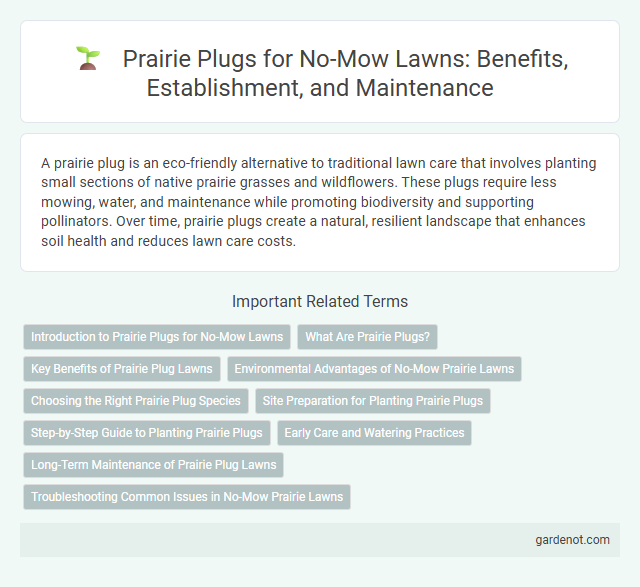A prairie plug is an eco-friendly alternative to traditional lawn care that involves planting small sections of native prairie grasses and wildflowers. These plugs require less mowing, water, and maintenance while promoting biodiversity and supporting pollinators. Over time, prairie plugs create a natural, resilient landscape that enhances soil health and reduces lawn care costs.
Introduction to Prairie Plugs for No-Mow Lawns
Prairie plugs consist of dense, native grass and wildflower clusters designed to establish low-maintenance, no-mow lawns that replicate natural prairie ecosystems. These plugs improve biodiversity, support pollinators, and reduce the need for watering and mowing, making them an eco-friendly alternative to traditional turfgrass. Ideal for sustainable landscaping, prairie plugs adapt well to various soil types and provide year-round visual interest with minimal upkeep.
What Are Prairie Plugs?
Prairie plugs are small sections of native prairie plants, typically 2 to 4 inches in diameter, used to establish a no-mow lawn by planting directly into existing turf or bare soil. These plugs contain a mix of deep-rooted grasses and wildflowers that require minimal mowing and promote biodiversity, soil health, and water conservation. Over time, prairie plugs expand and fill in to create a resilient, low-maintenance lawn alternative that supports local ecosystems.
Key Benefits of Prairie Plug Lawns
Prairie plug lawns enhance biodiversity by providing native plant habitats that support pollinators and beneficial insects. These lawns promote soil health through deep root systems that improve aeration and water retention, reducing erosion and runoff. Low maintenance requirements and drought tolerance make prairie plug lawns an eco-friendly alternative to traditional turf grass.
Environmental Advantages of No-Mow Prairie Lawns
Prairie plug planting enhances no-mow lawns by promoting native biodiversity, improving soil health through deep root systems, and reducing water usage due to prairie species' drought tolerance. These lawns sequester more carbon compared to traditional turf grass, contributing to climate change mitigation. Reduced mowing decreases fossil fuel consumption and lowers greenhouse gas emissions, aligning with sustainable landscaping practices.
Choosing the Right Prairie Plug Species
Selecting the right prairie plug species depends on the local climate, soil type, and sunlight availability to ensure optimal growth and sustainability. Native species such as Big Bluestem, Little Bluestem, or Purple Coneflower are ideal choices for promoting biodiversity and supporting pollinators in no-mow lawn settings. Prioritizing drought-tolerant and low-maintenance prairie plugs reduces water usage and minimizes upkeep while enhancing the natural landscape.
Site Preparation for Planting Prairie Plugs
Site preparation for planting prairie plugs involves removing existing grass and weeds through methods such as sod cutting, solarization, or herbicide application to reduce competition and enhance plug establishment. Soil should be loosened with a rake or tiller to ensure good root contact and promote water infiltration. Proper site preparation improves plug survival and supports the growth of native prairie species in a no-mow lawn setting.
Step-by-Step Guide to Planting Prairie Plugs
Plant prairie plugs in early spring or fall for optimal establishment, spacing them 12 to 18 inches apart to allow room for growth. Prepare the soil by removing existing vegetation and loosening the top 2 to 3 inches, then place plugs at soil level and press firmly to ensure good root contact. Water thoroughly after planting and maintain consistent moisture until plugs establish, typically within the first growing season.
Early Care and Watering Practices
Prairie plug plants require consistent early watering practices, ensuring the soil remains moist but not waterlogged to promote healthy root establishment. Applying water deeply once or twice a week is optimal during the first 4-6 weeks after planting, especially in drought-prone areas. Early care also involves minimal disturbance around plugs to reduce stress and support successful lawn establishment for a sustainable no-mow landscape.
Long-Term Maintenance of Prairie Plug Lawns
Prairie plug lawns require minimal long-term maintenance compared to traditional turf, relying on native grasses and wildflowers that naturally adapt to local soil and climate conditions. These lawns benefit from occasional seasonal mowing or controlled burns to promote healthy growth and suppress invasive species, reducing the need for fertilizers and irrigation. Over time, prairie plug lawns develop deep root systems that enhance soil stability and resilience, ensuring sustainable, low-maintenance landscapes.
Troubleshooting Common Issues in No-Mow Prairie Lawns
Prairie plug establishment often faces challenges such as poor root development and water stress, which can be mitigated by ensuring proper soil preparation and consistent moisture levels. Common issues like weed invasion can be controlled through targeted manual removal and the application of native plant-compatible herbicides. Regular monitoring for signs of pest damage and nutrient deficiencies is crucial for maintaining a healthy no-mow prairie lawn ecosystem.
Prairie plug Infographic

 gardenot.com
gardenot.com